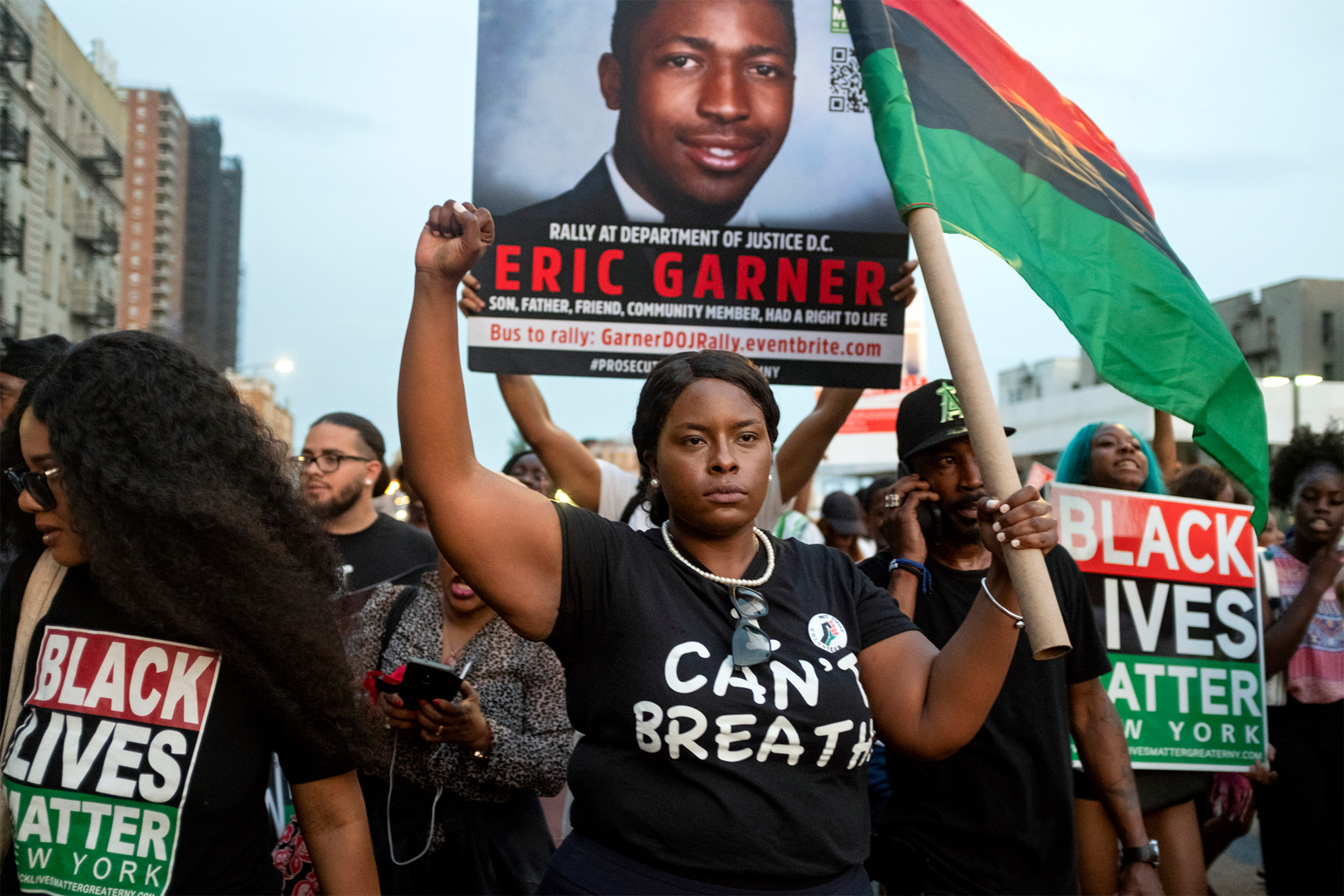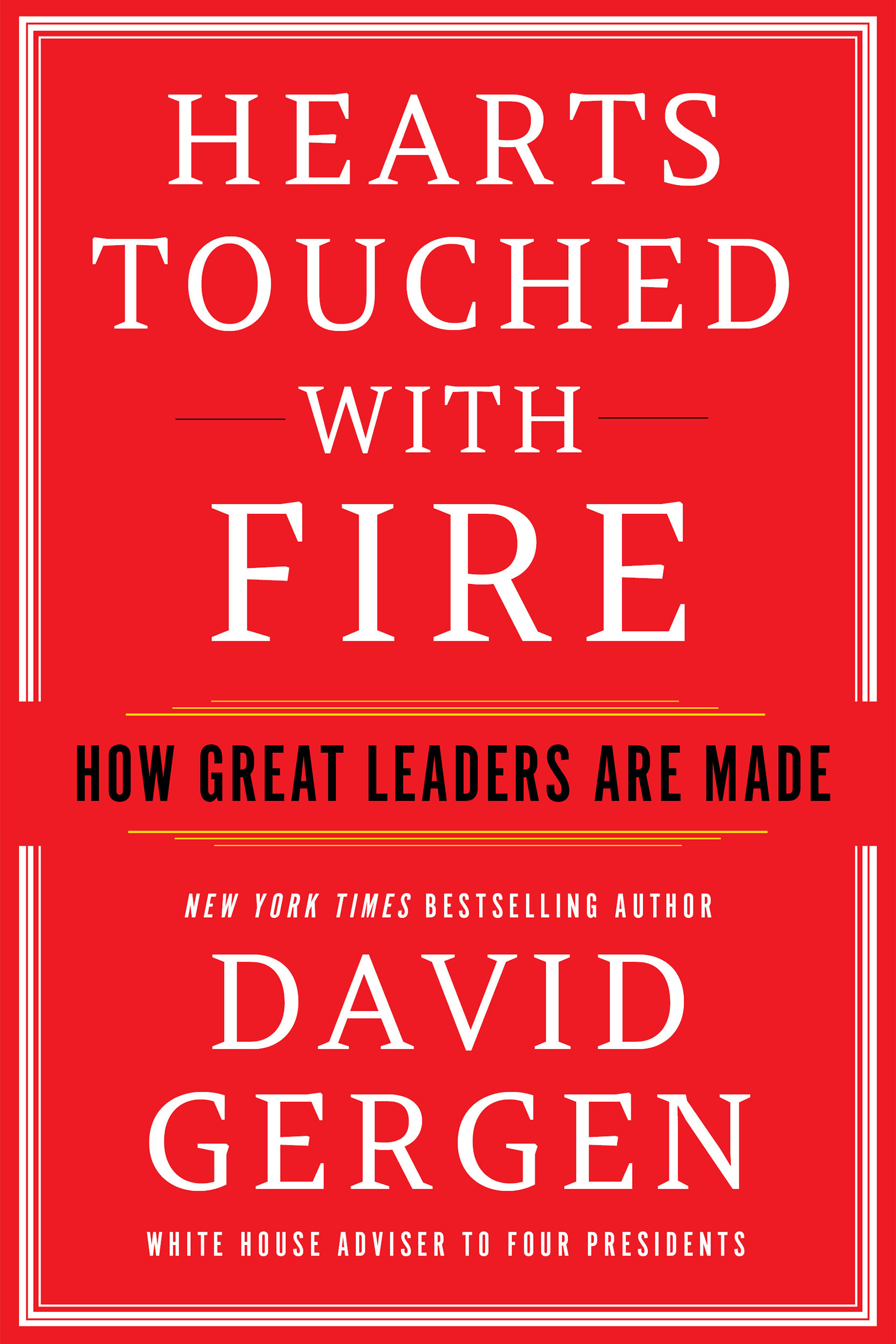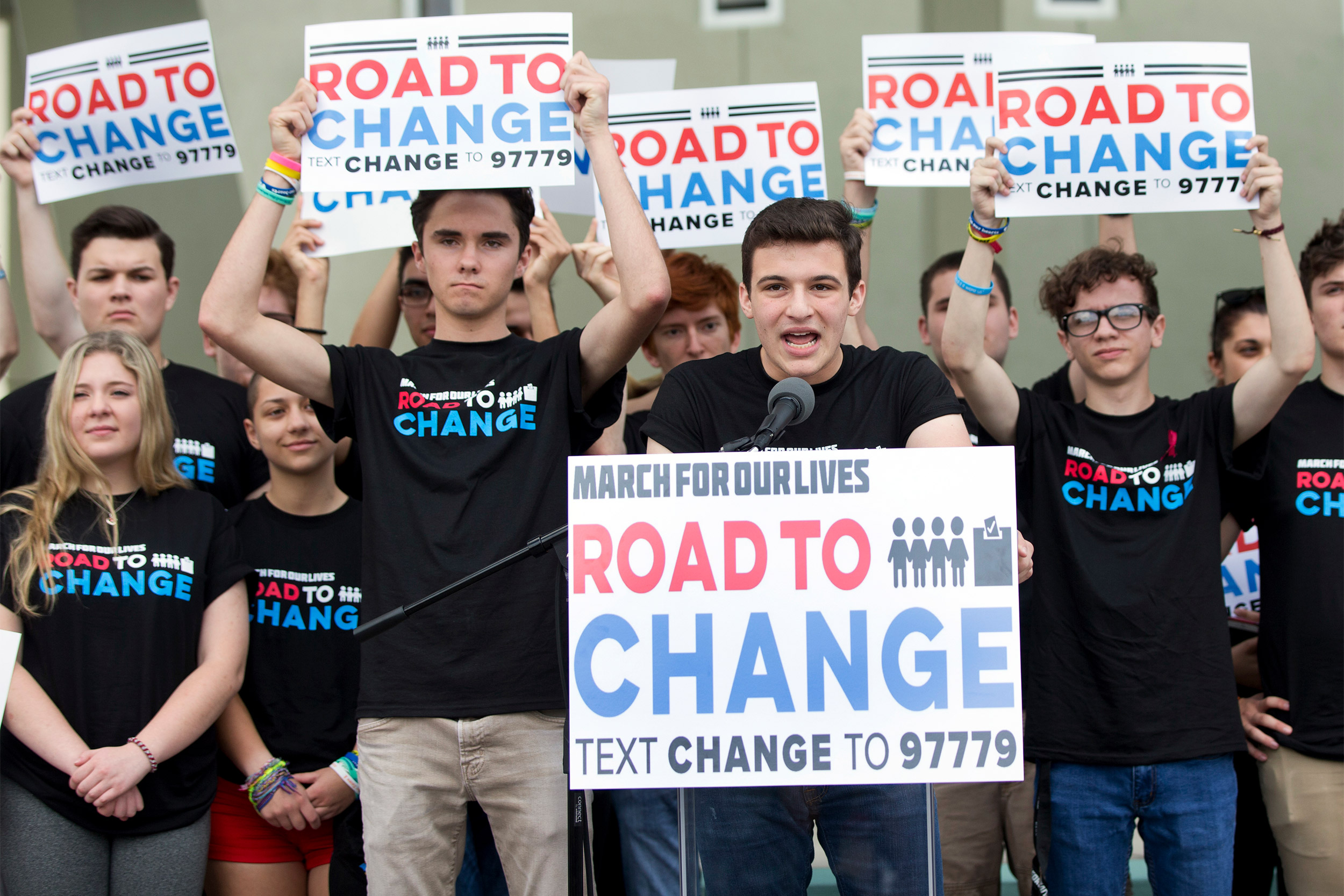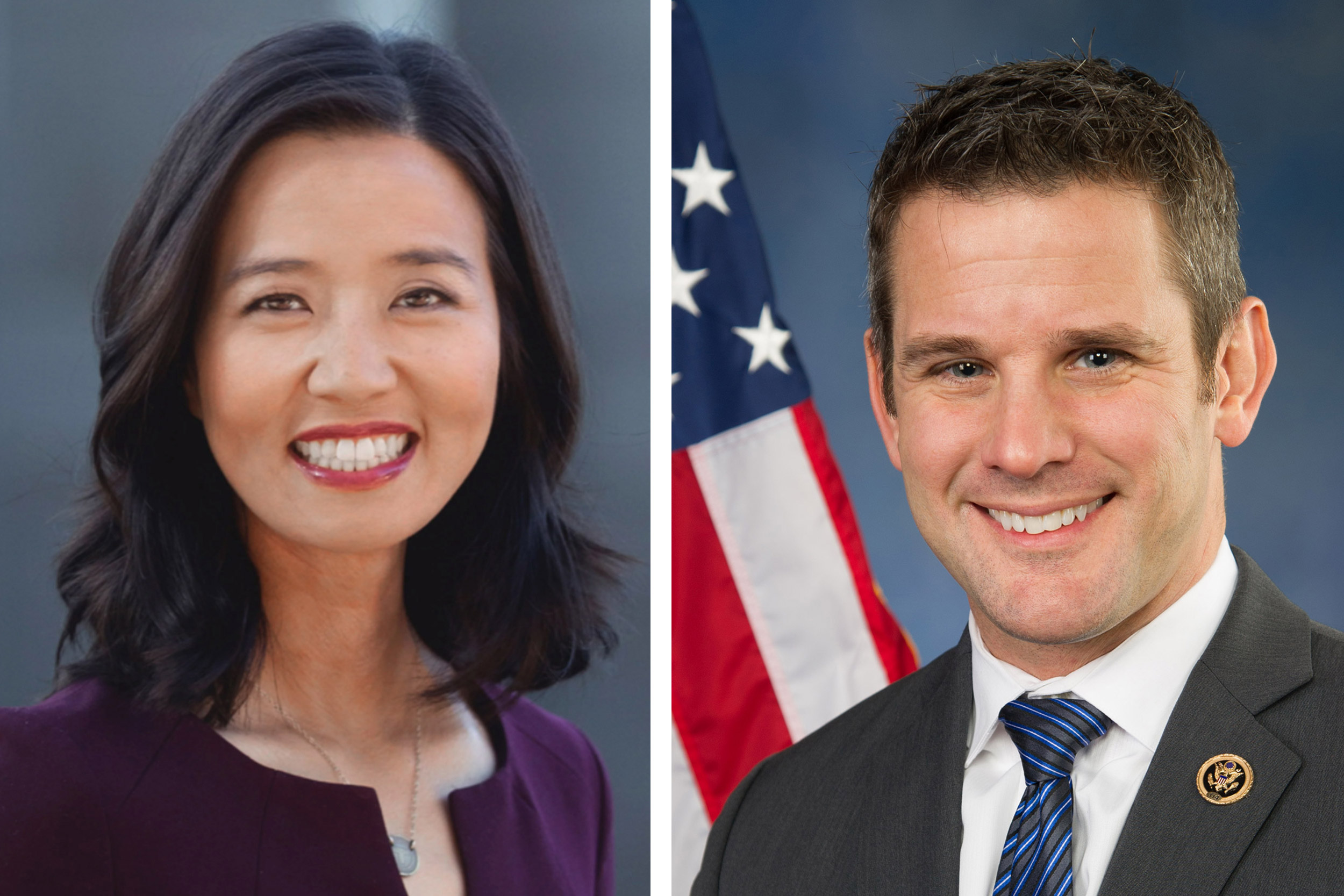
Black Lives Matter activists took to the streets following the federal prosecutors’ decision not to bring civil rights charges against a NYC police officer in the 2014 chokehold death of Eric Garner. It’s these movements, says David Gergen, that are increasingly changing the direction of the country.
AP Photo/Craig Ruttle
New breed of American leader
Some were elected; others lead fight for gun control, racial equity, environment. All embrace social media, their own True North.
Excerpted from “Hearts Touched with Fire: How Great Leaders Are Made” by David Gergen, professor of public service and founding director of the Center for Public Leadership at the Harvard Kennedy School.
We judge leaders by their legacies. The America that the World War II generation left behind was the strongest country in the world economically, militarily, scientifically, and culturally. While racism, sexism, and other forces were eating away at our undergirding, most Americans were still proud and confident about our democracy. United and well led, the World War II generation proved that, when inspired, we are a can-do people.

Those lessons from another generation are of growing significance today. Once again, we are facing an existential threat to the republic. Once again, we hear a clarion call for unity and action. Once again, we face the question: Will our citizenry answer the call?
The honest answer is that we don’t yet know whether the republic will survive as we have known it. Among public intellectuals, pessimism runs high. Books forecasting the demise of our democracy and the rise of an authoritarian state or, in some cases, a breakup of the union have now become a cottage industry. Certainly, the accelerating rise of global temperatures and the insanity we encounter when millions of our fellow citizens refuse to accept vaccinations, putting their own children at risk, are depressing.
Even so, the rising generations of today have the potential and, indeed, the promise that we saw in the World War II generation. On the face of it, one might expect Millennials and Gen Zers to be reluctant warriors in the struggle to revive our civic life. Over the course of their lives, they have been repeatedly battered by external events and crises. Fortunately, there are growing signs that many Millennials and Gen Zers are starting to do just the opposite: They are answering the call with a vengeance, just as we have seen with Greta Thunberg on the environment and the Parkland kids with gun control. They have channeled hard times into hope, living their lives with a sense of idealism that can propel us to better days.
In observing many of these rising stars in recent years, I have found that they are influencing almost every cross section of society, tackling problems at the heart of every field. They aren’t just challenging existing traditions; they want to reimagine the world. From my observation, I have found that in choosing their personal journeys, they tend to migrate into five different forms of leadership. In each, to borrow a phrase from Steve Jobs, they are starting to make “a dent in the universe.”
Social movements
For centuries, protests and activism have been a central feature of our democracy. The discontented have self-organized, taken to the streets, and demanded their leaders do better — from the Boston Tea Party (1763) to the Women’s Suffrage Parade (1913), from the March on Washington for Jobs and Freedom (1963) to the Women’s March (2017), from the Strike for Climate (2019) to the marches sparked by the murder of young Black Americans like Trayvon Martin, Michael Brown, Tamir Rice, and George Floyd.
For all his faults, Donald Trump paradoxically ushered in at least one change in current social movements: He spurred the resistance. His inauguration sparked a historic day of protests, as somewhere between 3 and 5 million protestors participated in the Women’s March in communities across the country. After that, young people poured into the resistance. Not since Vietnam and the turbulent 1960s have so many of the young stepped up and spoken out.

A day after graduating from high school, a group of school shooting survivors from Parkland, Florida, announced a multistate bus tour to “get young people educated, registered, and motivated to vote.”
AP Photo/Wilfredo Lee
These more recent demonstrations have several striking features. The first is the most important: These movements and their leaders are increasingly changing the direction of the country. Progress is painfully slow and frequently disappointing, but it is gathering force. Racial justice and income equity are now higher on the national agenda. A backlash is building on the right that could yet reverse our direction, but for now, the social swing is the most pronounced since the Progressive Era a century ago. Second, the protestors — and in particular, the activists — have discovered that the internet can often do as much to arouse and align followers as the streets. That gives resisters far more leverage. Third, the resistance is bringing a diverse cross section of people into action. The civil rights protests of the 1960s drew far more Black Americans than whites; that is no longer true.
Finally, the social movements of today are encouraging a different form of leadership, one we learned was inspired by the grassroots work of leaders like Ella Baker and transformed by the landscape of today. “Leader-full” movements — like BLM — do not have one person speaking for them, nor one person negotiating. They speak with a collective voice and are elevating the leadership of both young and old.
Elected officials
Young people are also reinvigorating our city halls, legislatures, and Congress itself, institutions that have often seemed sleepy and stale. Pete Buttigieg may be the best-known example: a Harvard undergrad, Rhodes Scholar, elected mayor of South Bend at 29, an improbable candidate for president whose talent turned him into people’s favorite underdog; and now, at 39, he has become the first openly gay person to serve in a presidential cabinet. Michael Tubbs is one of America’s best-kept secrets: Born to a teenage mother and incarcerated father, he was elected mayor of Stockton, California, at 26 — the youngest and first Black mayor in a city of 300,000. Another example: Aja Brown, youngest mayor of Compton, California, when she was 31. And another: Svante Myrick, youngest-ever mayor of Ithaca at 24, a person of color who rebuilt the center of his city. Michelle Wu, at 36, became the first woman and person of color elected mayor of Boston.

At 36, Michelle Wu became the first woman and person of color elected mayor of Boston. Rep. Adam Kinzinger (R-Ill.) is among the “mainstream moderates” attracting a new coalition of young voters, says Gergen.
Photos courtesy of City of Boston; Rep. Kinzinger
Coming off the elections of 2020, Millennials now occupy 31 seats in the House and one in the Senate. One stream of new, young faces comes from the left wing of the Democratic Party — most prominently, Alexandria Ocasio-Cortez and the Squad, a progressive cohort of House representatives with an increasing voice in the national agenda. A second stream is composed of military veterans and former intelligence officers who, like the World War II leaders, are trying to build bipartisan coalitions. They are the backbone among newly elected moderates on both sides of the aisle. Once seated in the House, some 25 veterans now belong to a For Country Caucus, working together across the aisle on national security issues such as bringing allies of the United States out of Afghanistan. (Disclosure: I am a co-founder of With Honor, a start-up to identify, recruit, and help win seats for the veterans’ group. Our hope is to help restore our civic life by rebuilding the center of American politics.)
I am a firm believer that a combination of new progressives and mainstream moderates will serve the country well. Ocasio-Cortez, Ilhan Omar, Conor Lamb, Seth Moulton, and Joe Neguse have become stars of the left, while Mike Gallagher, Peter Meijer, and Adam Kinzinger have been some of the most outspoken on the center-right — albeit on different levels of conservatism. Along the way, many of them used emerging technologies and modes of outreach to bring a new coalition of young voters and constituents into the fray.
Social entrepreneurs
A few decades ago, many of the young people who wanted to put the world aright became social entrepreneurs. Most were idealistic, passionate, white, and graduates from top colleges who thought the government was failing to meet social needs here and overseas. By applying the principles of business, they believed their organizations could find new solutions. Since then, their thinking has evolved: They now tend to believe that to achieve systemic change, they need to partner more with government, become more engaged in politics, and seek much greater diversity in their ranks.
Many of the early pioneers remain legends in the field. Bill Drayton is the godfather of social entrepreneurship, graduating from Harvard College and Yale Law, winning a master’s from Balliol, and working at McKinsey before launching the Ashoka nonprofit four decades ago. His central vision has held steady: “Everyone a Change Maker.” Today Ashoka partners up with some 300 nonprofits around the world. Wendy Kopp was an undergraduate at Princeton when she wrote a senior thesis proposing Teach For America; it now has 64,000 alumni serving 50 regions across the country and has expanded abroad. She met her husband, Richard Barth, when he came in for a job interview. Barth is now CEO of the KIPP Foundation, which has some 270 charter schools and 160,000 students and alumni.
After completing dual graduate degrees at Harvard, Cheryl Dorsey joined up with Echoing Green and became its CEO. Under her leadership, Echoing Green has provided early funding for almost a thousand social innovators, many of them successful. Michael Brown and Alan Khazei, roommates at the College, started City Year together at Harvard Law School; it was so successful in providing a year or two of urban service that President Clinton modeled AmeriCorps after it. Khazei’s wife, Vanessa Kirsch, started Public Allies in Chicago (where a young Michelle Obama worked for her) and went on to create New Profit, which provides mezzanine funding for dozens of promising new ventures. Most recently, a young woman named Emily Cherniack has created a smash hit called New Politics, which recruits servant leaders — military veterans and social entrepreneurs — to run for public office; she is an informal partner in arms with Rye Barcott, the founder in 2018 of With Honor, and Emily and Rye have become two of our most successful emerging leaders.
To their credit, all of these organizations are now aggressively seeking more diversity: From CEOs down through the ranks, demand is now high for more women and people of color and for graduates of a wider array of colleges to serve in leadership positions.
National service
One way in which some of these social entrepreneurs have left their mark is by ushering in the movement for national service. In recent years, a growing collection of American leaders have pushed for the creation of a modern corps of young volunteers who commit themselves to giving back a year or two to our country. Supporters have ranged from conservative William Buckley to Presidents Clinton, George W. Bush, Obama, and Biden, along with John McCain, Hillary Clinton, Elizabeth Warren, Pete Buttigieg, Bob Gates, Senator Chris Coons, and General Stanley McChrystal.
These past few years have highlighted ways in which young people can spur themselves into a life of leadership through service to community — either their local community or an underserved area in need of help. During the pandemic, AmeriCorps — the organization at the center of national service opportunities — enlisted volunteers to help communities across the country with efforts including contact tracing, food delivery service, and supplementing for gaps in education caused by remote learning environments. All told, AmeriCorps affiliates volunteered millions of hours to keep communities afloat after COVID.
However the pandemic may end, it has become clear that our communities have benefited from the service of young volunteers. Projects ranging from environmental conservation to disaster response efforts to supporting underserved schools all fall under the purview of these programs. And, in return, young volunteers gain valuable skills from their experiences. They learn to work toward a common goal with volunteers from all walks of life, understand the value of service, and emerge with a greater sense of commitment to country and cause.
Voices of Change
The fifth group is harder to categorize but is equally influential in shaping the national narrative. We might call them “voices of change.” They come from journalism, literature, sports, and nonprofits and command national platforms on television, podcasts, YouTube, newsletters, social media, and elsewhere online. One thinks of Amanda Gorman, who brought the nation to tears with her poetry at Biden’s inauguration. Or Abby Phillip and Kaitlan Collins, who have served as CNN anchor and chief White House correspondent, respectively. Or Natasha Bertrand at CNN and Astead Herndon at The New York Times. All are Millennials, the oldest among them barely breaking 30.
Even those you would not expect have taken it upon themselves to speak up for social good. Megan Rapinoe led her soccer team to victory in the World Cup and then used her platform to promote equitable pay. Colin Kaepernick put his career on the line when he bravely took a knee to demand racial justice. Hundreds of young professional athletes followed him, supporting the Black Lives Matter movement. This year, gymnast Simone Biles and tennis star Naomi Osaka made themselves heard not just for their athletic dominance but for their advocacy. Both were courageous enough to bring international attention to mental health, an issue long overlooked in the athletic community and beyond. This account is not meant to be anywhere near exhaustive but instead should be inspirational. Young people who have been knocked down have scrambled back up, their voices now heard across the nation.
Clearly all of these young trailblazers have found that the practice of leadership is not for the faint of heart. It is hard, grueling, and often thankless work as critics fire poisonous arrows your way. And the higher you climb, the tougher it gets. But the fact that leadership is hard should not force a retreat but serve as motivation to toughen up. In addition a leader needs an inner compass — a True North — by which to steer and an outer strength that will help overcome obstacles. At the end of the day, leaders find the harder the journey, the greater the satisfaction upon completing it.
Copyright © by David Gergen 2022. Published with permission from Simon & Schuster, Inc.




